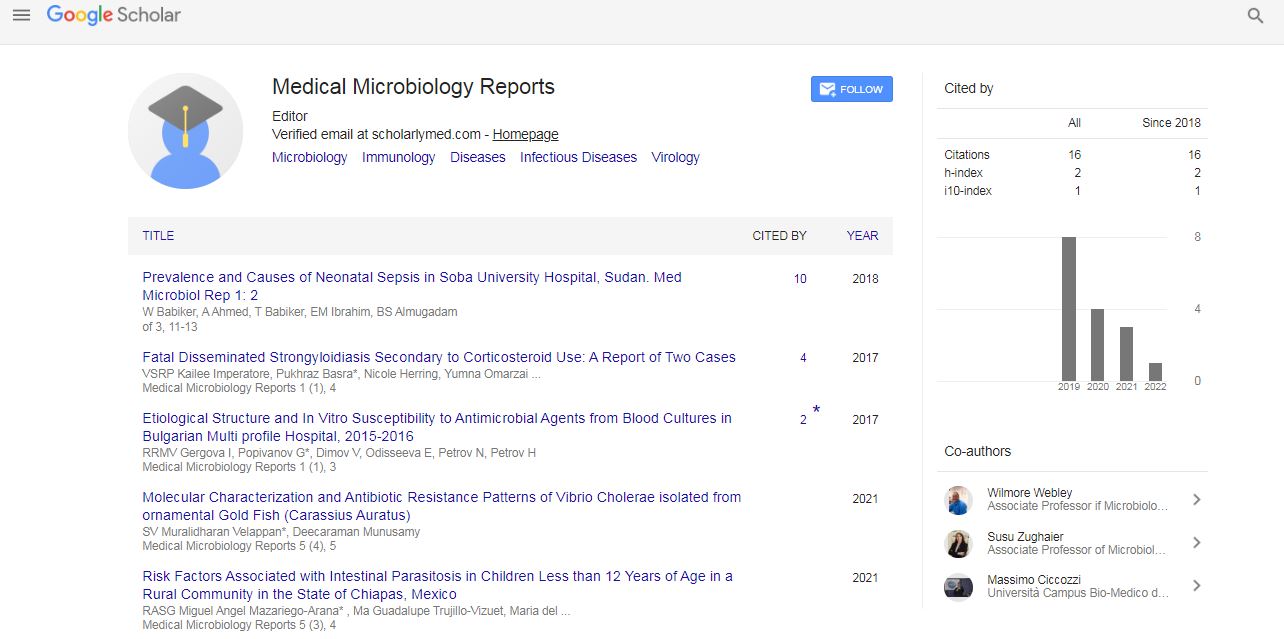Opinion Article, Med Microbiol Rep Vol: 7 Issue: 1
Diagnostics on Viral Infections: An Overview of Virology
Roderick P Neumann*Department of Global and Sociocultural Studies, Florida International University,Miami, USA
*Corresponding Author: Roderick P Neumann
Department of Global and
Sociocultural Studies
Florida International University, Miami, USA
E-mail: roderick@fiu.edu
Received date: 27 February, 2023, Manuscript No. MMR-23-96432;
Editor assigned date: 01 March, 2023, PreQC No. MMR-23-96432(PQ);
Reviewed date: 15 March, 2023, QC No. MMR-23-96432;
Revised date: 22 March, 2023, Manuscript No. MMR-23-96432(R);
Published date: 31 March, 2023 DOI: 10.4172/MMR.1000331.
Citation: Neumann RP (2023) Diagnostics on Viral Infections: An Overview of Virology. Med Microbiol Rep 7:1.
Description
Viral infections pose significant threats to human health, with outbreaks and pandemics often causing widespread morbidity and mortality. Virology, the study of viruses, encompasses a broad range of scientific disciplines, including virological research, diagnostics, and antiviral therapies discussing the structure, replication, and pathogenesis of viruses, as well as the strategies for their detection and treatment.
Structure of viruses
Viruses are small, infectious agents composed of genetic material, either DNA or RNA, surrounded by a protein coat called a capsid. Some viruses also have an outer envelope made of lipids. The combination of genetic material and capsid or envelope determines the virus's shape, size, and ability to infect specific host cells. Viruses can have various shapes, such as spheres (e.g., adenoviruses), rods (e.g., tobacco mosaic virus), or complex structures (e.g., bacteriophages). Understanding the structure of viruses is an important for developing antiviral therapies that target specific viral components.
Replication of viruses
Viral replication involves a series of steps that allow the virus to enter a host cell, use the cellular apparatus of the host to proliferate, and release new viral particles to infect other cells. The replication process varies among different types of viruses, but typically includes attachment to specific receptors on the host cell surface, entry into the host cell, replication of viral genetic material, assembly of new viral particles, and release from the host cell. Viral replication can cause damage to the host cell, leading to the characteristic symptoms of viral infections. The study of viral replication is important for understanding the mechanisms underlying viral pathogenesis and developing antiviral therapies that disrupt viral replication.
Pathogenesis of viral infections
Viral infections can cause a wide range of diseases, ranging from mild respiratory infections to severe illnesses such as AIDS, Ebola, and influenza. The pathogenesis of viral infections involves complex interactions between the virus and the host immune system. Upon infection, viruses can evade or manipulate the host immune response to establish infection and spread to other cells or tissues. Viral pathogenesis can result from direct damage to host cells by viral replication, immune responses triggered by viral infection, or a combination of both. The severity of viral infections depends on factors such as the type of virus, the host's immune response, and the presence of other underlying health conditions. Understanding viral pathogenesis is essential for developing strategies to prevent and treat viral infections.
Detection of viruses
Rapid and accurate detection of viruses is an important for controlling viral outbreaks and pandemics. Virologists employ various methods to detect viral infections, including molecular techniques, serological assays, and viral culture. Molecular techniques such as Polymerase Chain Reaction (PCR) are highly sensitive and specific, allowing for the detection and identification of viral genetic material in clinical samples. Serological assays detect antibodies produced by the host in response to viral infection, providing information about the previous exposure to a virus. Viral culture involves isolating and growing viruses in the laboratory, which is essential for studying virus properties and developing vaccines. Timely and accurate detection of viruses is essential for guiding appropriate clinical management and implementing effective public health measures to control viral outbreaks.
Treatment of viral infections
Antiviral therapies are important for managing viral infections, and they can target different stages of the viral replication cycle, including viral attachment, entry, replication, assembly, and release. Antiviral drugs can inhibit viral replication, reduce viral load, and alleviate symptoms of viral infections. Some examples of antiviral drugs include nucleoside analogs.
 Spanish
Spanish  Chinese
Chinese  Russian
Russian  German
German  French
French  Japanese
Japanese  Portuguese
Portuguese  Hindi
Hindi 
